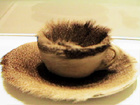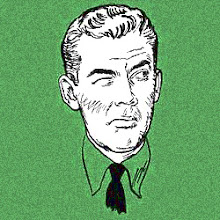 One day in late September 1959, Brion Gysin was mounting some drawings in his hotel room. Cutting the boards with his knife, he also sliced through a pile of old newspapers that he'd placed under the boards to protect his table. When he was done cutting the boards, he noticed that the New York Herald Tribune had been sliced in strips and that the words in print lined up and could be read across the sliced strips. This combined stories from different pages. He loved the results.
One day in late September 1959, Brion Gysin was mounting some drawings in his hotel room. Cutting the boards with his knife, he also sliced through a pile of old newspapers that he'd placed under the boards to protect his table. When he was done cutting the boards, he noticed that the New York Herald Tribune had been sliced in strips and that the words in print lined up and could be read across the sliced strips. This combined stories from different pages. He loved the results. By the time William S. Burroughs returned to the hotel (he'd been lunching with reporters), Brion was almost hysterical with excitement about his discovery. The two began to experiment with the process, soon calling it "Cut-ups."
"Of course, when you think of it, 'The Waste Land' was the first great cut-up collage, and Tristan Tzara had done a bit along the same lines." He credited John Dos Passos as well - the Dos of "the Camera's Eye" sequences in USA.
Perhaps Burroughs' most significant conclusion: "A page of Rimbaud cut up and rearranged will give you quite new images - real Rimbaud images - but new ones."
Gysin was a great influence on Burroughs in 1959 and 1960 and later. He got him interested in the followers of Hassan (political cult --> assassinations --> hashish) and in the Church of Scientology too.
 But back to Cut-ups. Minutes to Go, published in 1960, was the result of Gysin's turning WB on at the Beat Hotel. Burroughs: "Minutes to Go contains unedited unchanged cut ups emerging as quite coherent and meaningful prose. The cut-up method brings to writers the collage, which has been used by painters for fifty years. And used by the moving and still camera. In fact all street shots from movie or still cameras are by the unpredictable factors of passers by and juxtaposition cut-ups. And photographers will tell you that often their best shots are accidents . . . writers will tell you the same. The best writing seems to be done almost by accident...."
But back to Cut-ups. Minutes to Go, published in 1960, was the result of Gysin's turning WB on at the Beat Hotel. Burroughs: "Minutes to Go contains unedited unchanged cut ups emerging as quite coherent and meaningful prose. The cut-up method brings to writers the collage, which has been used by painters for fifty years. And used by the moving and still camera. In fact all street shots from movie or still cameras are by the unpredictable factors of passers by and juxtaposition cut-ups. And photographers will tell you that often their best shots are accidents . . . writers will tell you the same. The best writing seems to be done almost by accident...."Later Burroughs taught cut-up technique to Genesis P-Orridge as a method for "altering reality". Burroughs' insisted that everything is recorded, and if it is recorded, then it can be edited. P-Orridge employed cut-ups as an applied philosophy, a way of creating art and music.
UbuWeb's great "UbuWeb Papers" section includes Burroughs' essay "The Cut-Up Method of Brion Gysin".
More on The Beat Hotel here.

 Is '60 the moment when the end of the end of the Old Left had been reached and the New Left began to emerge? Is it the final ascendancy, in certain scenes at least, of poetic postmodernity? Surely the publication of Donald Allen's The New American Poetry that year suggests this, but then again--once again--we look back on "New" here and see continuity. The rhetoric of the Kennedy-Nixon contest made much less of a dent than everyone (at the time as well as since) claimed, so one wonders why were such great claims made?
Is '60 the moment when the end of the end of the Old Left had been reached and the New Left began to emerge? Is it the final ascendancy, in certain scenes at least, of poetic postmodernity? Surely the publication of Donald Allen's The New American Poetry that year suggests this, but then again--once again--we look back on "New" here and see continuity. The rhetoric of the Kennedy-Nixon contest made much less of a dent than everyone (at the time as well as since) claimed, so one wonders why were such great claims made?  Had we come to expect "1960" to be truly ubiquitously modern in a way that the 1950s really were not--not quite? And what specifically does "modern" mean in the Kennedyesque talk then and now about the torch being passed to a new generation, etc.? The First Lady really meant "modernist" when Camelotians said "modern." What about the others across the new young cultural leadership? I've been surprised by how frequently the
Had we come to expect "1960" to be truly ubiquitously modern in a way that the 1950s really were not--not quite? And what specifically does "modern" mean in the Kennedyesque talk then and now about the torch being passed to a new generation, etc.? The First Lady really meant "modernist" when Camelotians said "modern." What about the others across the new young cultural leadership? I've been surprised by how frequently the  "Beat movement" was covered in 1960 in the mainstream press. I was expecting a fair measure but I've found tonnage. 1960 was the year when the figure of the beat was beginning to find acceptance, although still 80% of these stories are mocking, rebels-without-cause condescension. For anyone whose analysis made an impact nationally, do these antipolitical adolescents count as part of the "new young cultural leadership"? No, but rather than the two being opposites, they fall along a Continuum of the New American. Now that's a change for '60.
"Beat movement" was covered in 1960 in the mainstream press. I was expecting a fair measure but I've found tonnage. 1960 was the year when the figure of the beat was beginning to find acceptance, although still 80% of these stories are mocking, rebels-without-cause condescension. For anyone whose analysis made an impact nationally, do these antipolitical adolescents count as part of the "new young cultural leadership"? No, but rather than the two being opposites, they fall along a Continuum of the New American. Now that's a change for '60.







